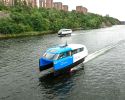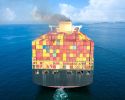Intermodal transport profitable on longer distances
Transhipment from road can be profitable on distances that exceed 1,000 km. This according to a study from the European Commission that analyzes different transhipment options to achieve intermodal transport.
The idea of intermodal transport is to make it possible to move passengers and goods in a fast, efficient and coordinated way with a wide range of modes of transport, including air, boat, rail and road. It is about finding the most efficient combination of several means of transport, using the strengths of the different modes of transport, such as convenience, speed, cost, reliability and predictability. This in turn increases environmental sustainability and reduces the climate footprint of transport.
So far, however, intermodal transport is generally more expensive, slower and less reliable than road transport. The disadvantages include long delivery times, complexity, higher risk and lower reliability. This is mainly due to the lack of suitable terminal infrastructure and low investment levels in smart digital solutions that would streamline the management of multimodal transport flows.
However, a new study from the European Commission shows that the standard technology for vertical transhipment in combination with containers is competitive with road transport at distances over 1,000 km. If the external environmental costs are taken into account, intermodal transport in comparison with clean road transport could be profitable already at 600 km.
However, the intermodal system needs to be developed, the study states. By 2030, transhipment capacity in the EU will not be sufficient to meet demand. Therefore, additional terminal capacity must be invested in the Trans-European Transport Network (TEN-T), which requires careful planning, given that compatible transhipment solutions must be available at both ends of a railway and waterborne section.
Footnote: The Trans-European Transport Network (TEN-T) is a policy for implementing the development of a European network of railways, roads, inland waterways, shipping routes, ports, airports and railway terminals. Ten-t is defined in an EU regulation (EU 1315/2013). The regulation contains goals and guidelines for how the network is to be developed by 2030 and 2050.
-
 NextWave – en podd som ska locka unga
NextWave – en podd som ska locka unga -
 Ny studie: Eldrivna pendelbåtar kan effektivisera Stockholms kollektivtrafik
Ny studie: Eldrivna pendelbåtar kan effektivisera Stockholms kollektivtrafik -
 Sjöfartens utsläpp ökar
Sjöfartens utsläpp ökar -
 Sociala relationer påverkar val av bränsle
Sociala relationer påverkar val av bränsle -
 Sjöfartens omställning kräver ”mjukare” påtryckningar
Sjöfartens omställning kräver ”mjukare” påtryckningar -
 Hon hade avtalad tid med Kapten ynkrygg
Hon hade avtalad tid med Kapten ynkrygg -
 Lighthouse omvärldsanalys 2025 – osäkerhet och tullar präglar sjöfarten
Lighthouse omvärldsanalys 2025 – osäkerhet och tullar präglar sjöfarten -
 Se seminariet Shipping in the Marine Environment
Se seminariet Shipping in the Marine Environment -
 Vad betyder egentligen de 90 procenten?
Vad betyder egentligen de 90 procenten? -
 Hålla där...
Hålla där...

